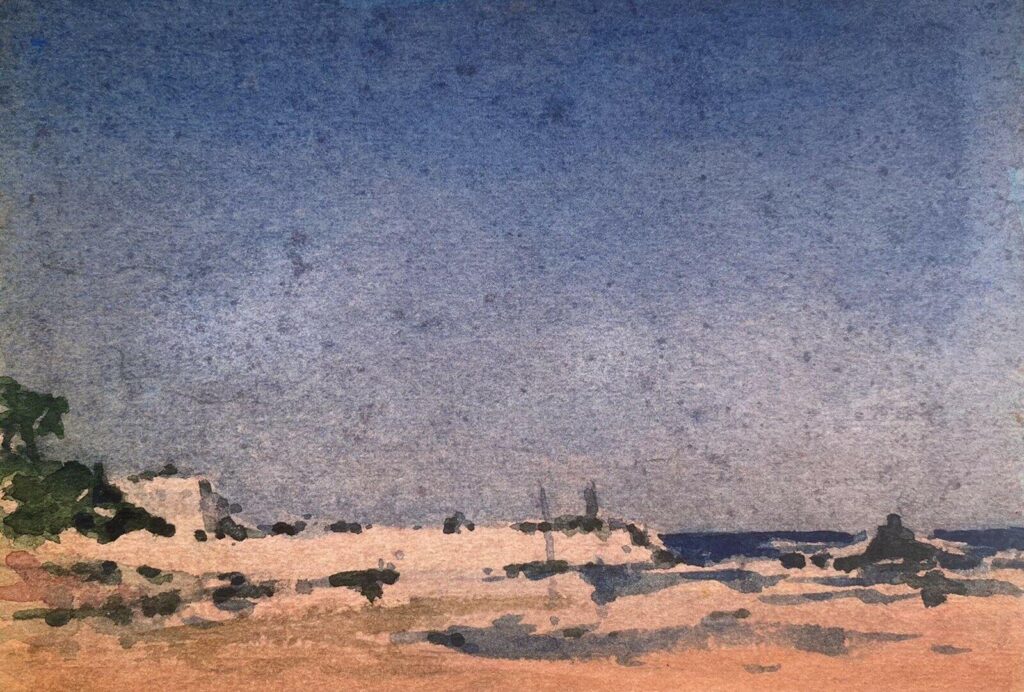
Chasing Horizons: The Allure of Blue Sky Landscapes
There’s something undeniably captivating about blue sky landscapes. They evoke feelings of freedom, peace, and boundless possibility. Whether it’s a sweeping vista of rolling hills beneath a cerulean dome or a tranquil coastal scene where the azure sky meets the turquoise sea, these scenes resonate deeply within us. This article explores the enduring appeal of blue sky landscapes, examining their aesthetic qualities, psychological impact, and practical considerations for photographers and artists seeking to capture their essence.
The Psychology of Blue Skies
The color blue is often associated with calmness, serenity, and stability. Studies have shown that exposure to blue can lower blood pressure and heart rate, promoting relaxation. A blue sky landscape, therefore, can be inherently therapeutic. The vastness of the sky itself can inspire a sense of awe and wonder, reminding us of the scale of the universe and our place within it. This feeling of connection to something larger than ourselves can be profoundly comforting and uplifting. Furthermore, clear blue sky landscapes often signify good weather, which in turn is linked to outdoor activities and positive experiences. Think of picnics, hiking, and simply enjoying the sunshine – all activities enhanced by a vibrant blue sky.
Aesthetic Elements of Blue Sky Landscapes
The beauty of a blue sky landscape lies not only in the color itself but also in the interplay of light, shadow, and form. The position of the sun dramatically affects the appearance of the sky, creating a spectrum of hues from the pale blues of dawn to the intense, saturated blues of midday. Clouds add another layer of visual interest, ranging from wispy cirrus clouds that streak across the sky like brushstrokes to towering cumulus clouds that cast dramatic shadows across the land. The contrast between the blue sky and the earth below is also crucial. Green fields, golden beaches, or snow-capped mountains all provide a striking counterpoint to the azure above, creating a visually compelling scene. Consider the impact of different times of day on these landscapes. The golden hour, for example, can transform a simple blue sky landscape into a breathtaking spectacle of color.
Capturing the Perfect Blue Sky Landscape: Tips for Photographers
Photographing blue sky landscapes can be challenging. The bright sky can easily overwhelm the camera’s sensor, resulting in underexposed foregrounds and blown-out skies. Here are some tips to help you capture stunning blue sky landscapes:
- Use a polarizing filter: A polarizing filter reduces glare and reflections, making the blue sky appear richer and more saturated. It also helps to darken the sky, creating a greater contrast with the clouds.
- Shoot in RAW format: Shooting in RAW format allows you to capture more detail and dynamic range than shooting in JPEG. This gives you more flexibility when editing your photos.
- Use a graduated neutral density (GND) filter: A GND filter darkens the bright sky while leaving the foreground unaffected. This helps to balance the exposure and prevent the sky from being overexposed.
- Focus on composition: Pay attention to the composition of your shot. Use leading lines, the rule of thirds, and other compositional techniques to create a visually appealing image.
- Shoot at the right time of day: The best time to photograph blue sky landscapes is during the golden hour (the hour after sunrise and the hour before sunset). During this time, the light is soft and warm, and the colors are more vibrant.
The Role of Clouds in Blue Sky Scenery
While a perfectly clear blue sky is beautiful in its simplicity, clouds add depth, texture, and drama to a landscape. Different types of clouds evoke different moods. Cumulus clouds, with their fluffy, cotton-like appearance, often suggest a bright and cheerful day. Stratus clouds, on the other hand, can create a sense of overcast melancholy. Cirrus clouds, with their delicate, wispy forms, add a touch of ethereal beauty. Learning to identify different types of clouds can help you predict the weather and plan your photography accordingly. The interplay between the blue sky and the clouds is essential to creating visually stunning and emotionally resonant images. Don’t underestimate the power of a well-placed cloud to transform a blue sky landscape from ordinary to extraordinary.
Painting the Blue Sky: Techniques for Artists
For artists, capturing the nuances of a blue sky landscape presents a unique set of challenges. Achieving the right color and luminosity requires careful attention to detail and a mastery of painting techniques. Here are some tips for painting blue sky landscapes:
- Mix your blues carefully: Avoid using a single tube of blue paint straight from the tube. Instead, experiment with mixing different blues (such as ultramarine blue, cerulean blue, and phthalo blue) with white and other colors to achieve the desired hue.
- Use thin layers of paint: Build up the color gradually using thin layers of paint. This will create a more luminous and atmospheric effect.
- Pay attention to the light: Observe how the light affects the color of the sky. The sky is often lighter near the horizon and darker towards the zenith.
- Consider the clouds: Don’t forget to include the clouds in your painting. Use different brushstrokes and techniques to create the texture and form of the clouds.
- Practice regularly: The best way to improve your painting skills is to practice regularly. Experiment with different techniques and approaches until you find what works best for you.
Blue Sky Landscapes Around the World
The beauty of blue sky landscapes can be found all over the world. From the vast plains of the American Midwest to the rugged coastlines of Europe, the combination of blue skies and stunning scenery is a universal source of inspiration. The specific character of these landscapes varies depending on the location. In the Mediterranean, the blue sky is often a deep, intense azure, reflecting the clear waters of the sea. In the tropics, the blue sky is often punctuated by towering cumulus clouds, creating a dramatic and dynamic scene. Exploring different blue sky landscapes around the world can broaden your artistic horizons and inspire you to see the world in a new light. Whether you’re photographing the rolling hills of Tuscany under a brilliant blue sky or painting the snow-capped peaks of the Himalayas beneath an azure dome, the possibilities are endless. The key is to be open to the beauty that surrounds you and to capture the essence of each unique landscape. Think of the Australian outback with its expansive blue sky and red earth, or the Scottish Highlands with their dramatic blue sky and moody landscapes. Each location offers a unique interpretation of the blue sky landscape theme.
Preserving Our Blue Sky Landscapes
The beauty of blue sky landscapes is not something we can take for granted. Air pollution and climate change are threatening the quality of our skies and the health of our planet. It’s important to take steps to reduce our environmental impact and protect these precious landscapes for future generations. This includes supporting sustainable tourism, reducing our carbon footprint, and advocating for policies that protect our air and water quality. By working together, we can ensure that future generations will be able to enjoy the beauty and tranquility of blue sky landscapes for years to come. Consider supporting organizations dedicated to environmental conservation and promoting responsible travel practices. Every action, no matter how small, can make a difference in preserving these invaluable landscapes.
The Enduring Appeal of Blue Sky Landscapes
In conclusion, the allure of blue sky landscapes is multifaceted. It stems from the psychological impact of the color blue, the aesthetic beauty of the interplay between sky and earth, and the emotional connection we feel to these vast and inspiring scenes. Whether you’re a photographer, an artist, or simply someone who appreciates the beauty of nature, blue sky landscapes offer a constant source of inspiration and wonder. By understanding the elements that make these landscapes so captivating, we can better appreciate their value and work to protect them for future generations. So, the next time you find yourself beneath a blue sky, take a moment to appreciate its beauty and reflect on the power of nature to inspire and uplift us. [See also: Landscape Photography Tips] [See also: Best Landscape Painting Techniques] [See also: Understanding Atmospheric Perspective]

